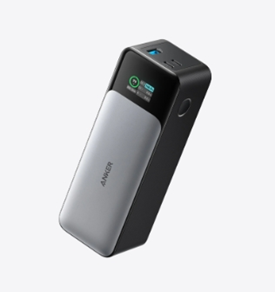Portable power has become a necessity in our daily lives. Whether you're commuting, traveling, or simply working remotely, a reliable power bank charger can be a lifesaver. However, not all power banks are created equal. With so many options available, it can be overwhelming to determine which one is worth your money. In this article, we’ll explore the key features—battery capacity, charging speed, portability, and safety—that make a power bank a worthwhile investment for your everyday needs.

Battery Capacity: How Much Power Do You Really Need?
When choosing a power bank, battery capacity is one of the most critical factors to consider. It determines how many times you can recharge your devices before the power bank itself needs to be recharged. But how much capacity do you actually need?
Matching Capacity with Your Devices
The capacity of a power bank is measured in milliampere-hours (mAh). For example, a 10,000mAh power bank can theoretically charge a smartphone with a 3,000mAh battery about three times. However, real-world efficiency is often lower due to energy loss during charging. If you primarily use your power bank to charge your phone, a 10,000mAh model is usually sufficient. On the other hand, if you need to charge larger devices like tablets or laptops, you might want to consider a power bank with 20,000mAh or more. Anker’s power banks, for instance, offer a range of capacities to suit different needs, ensuring you always have enough juice for your devices.
High-Capacity vs. Compact Power Banks: Finding the Balance
While high-capacity power banks are great for extended use, they tend to be bulkier and heavier. This can be a drawback if you’re always on the go. Compact power banks, on the other hand, are lightweight and easy to carry but may not provide enough power for multiple charges. The key is to find a balance that suits your lifestyle. For example, Anker’s compact 10,000mAh power banks are perfect for daily commutes, while their 20,000mAh models are ideal for longer trips. Consider your usage patterns and choose a power bank that offers the right mix of capacity and portability.
Charging Speed: Why Fast Charging Saves Time
In today’s fast-paced world, waiting hours for your devices to charge is simply not practical. Fast charging technology has become a game-changer, allowing you to power up your devices in a fraction of the time. But what makes a power bank charge faster?
Power Delivery (PD) and Quick Charge (QC) Technology
Power Delivery (PD) and Quick Charge (QC) are two of the most popular fast-charging technologies. PD is commonly used for laptops and high-end smartphones, while QC is more prevalent in Android devices. Anker’s power banks often feature both technologies, ensuring compatibility with a wide range of devices. For instance, their PowerCore III 19,000mAh power bank supports 18W PD, allowing you to charge a MacBook or iPhone at optimal speeds. If you’re someone who’s always on the move, investing in a power bank with fast-charging capabilities can save you valuable time.
Input vs. Output Speeds: How It Affects Charging Efficiency
It’s not just about how fast your power bank can charge your devices—it’s also about how quickly the power bank itself can be recharged. A power bank with a high input speed can be fully charged in just a few hours, making it ready for use again. Anker’s power banks often feature bi-directional fast charging, meaning both input and output speeds are optimized. For example, the Anker 737 Power Bank can recharge itself at 140W, ensuring minimal downtime. This is especially useful for frequent travelers who need their power bank ready at all times.

Portability and Design: Finding the Right Fit for Your Lifestyle
A power bank’s design and portability play a significant role in its usability. After all, what good is a power bank if it’s too bulky to carry around? Let’s explore how size, weight, and additional features can impact your experience.
Size, Weight, and Travel-Friendliness
When it comes to portability, size and weight matter. A slim, lightweight power bank is easy to slip into your bag or even your pocket, making it ideal for daily use. Anker’s PowerCore Slim 10,000mAh power bank, for example, is barely thicker than a smartphone and weighs just 180 grams. On the other hand, larger power banks, while offering more capacity, can be cumbersome to carry. If you’re a frequent traveler, consider a power bank that strikes the right balance between capacity and portability.
Extra Features: Built-in Cables, Wireless Charging, and More
Some power banks come with extra features that enhance convenience. Built-in cables, for instance, eliminate the need to carry separate charging cables, making them perfect for on-the-go use. Wireless charging is another feature that’s gaining popularity. Some Anker’s model, for example, double as a wireless charger, allowing you to charge compatible devices without any cables. These additional features can make a power bank more versatile and user-friendly, adding value to your investment.
Safety Features: Ensuring Reliable and Secure Charging
Safety should never be overlooked when choosing a power bank. A poorly designed power bank can pose risks such as overheating, overcharging, or even short-circuiting. Let’s delve into the safety features that make a power bank reliable.
Overcharge, Overheat, and Short-Circuit Protection
High-quality power banks come equipped with multiple safety mechanisms to protect both the device and the user. Overcharge protection prevents your devices from being damaged by excessive charging, while overheat protection ensures the power bank doesn’t get too hot during use. Short-circuit protection is another critical feature that safeguards against electrical faults. Anker’s power banks are known for their robust safety features, including MultiProtect safety technology, which combines these protections into a single system. This ensures a safe and reliable charging experience every time.
Certifications and Quality Standards to Look For
When shopping for a power bank, it’s essential to look for certifications that indicate quality and safety. Certifications like CE, FCC, and RoHS are good indicators that the product meets international safety standards. Anker’s power banks are rigorously tested and certified, giving you peace of mind when using them. Additionally, their products often come with warranties, further demonstrating their commitment to quality and customer satisfaction.
Conclusion
In conclusion, selecting the right power bank comes down to understanding your specific needs and prioritizing the features that matter most. Whether it’s battery capacity for extended use, fast charging to save time, a portable design for on-the-go convenience, or robust safety features for peace of mind, a high-quality power bank can significantly enhance your daily life. By carefully evaluating these factors, you can find a power bank that not only meets but exceeds your expectations. A well-chosen power bank is more than just a gadget—it’s a reliable companion that ensures your devices stay powered whenever and wherever you need them. Investing in a power bank that aligns with your lifestyle is a decision that will pay off in convenience, efficiency, and long-term value.